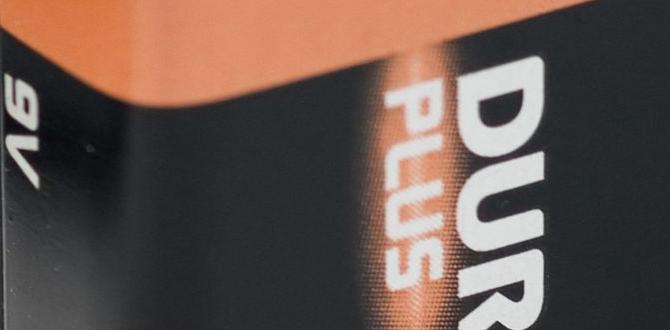Summary: Get the most life from a cheap lead acid car battery by understanding its basics, proper maintenance, and recognizing when it’s time for a replacement. Choosing wisely and caring for it ensures reliability and saves you money.
Your Car Battery: The Heart of Your Vehicle
Ever been stuck with a dead car? It’s frustrating, right? The culprit is often the car battery. While many batteries are available, the humble lead acid car battery remains a champion for its affordability and dependable power. But how do you get the longest life out of one, especially if you’re looking for a budget-friendly option? Don’t worry, it’s simpler than you think!
This guide will walk you through everything you need to know. We’ll cover what makes a good cheap lead acid battery, easy ways to keep it healthy, and how to spot trouble before it leaves you stranded. Let’s make sure your car starts every time!
Understanding the Cheap Lead Acid Car Battery
Lead acid car batteries are the most common type. They’ve been around for ages, and for good reason! They are robust, provide a lot of power for starting your engine, and are generally the most cost-effective. When we talk about a “cheap” lead acid battery, we mean one that offers great value for its price. It doesn’t mean it’s low quality; it means you’re getting a solid, essential power source without breaking the bank.
How They Work (The Simple Version)
Inside a lead acid battery are lead plates submerged in an electrolyte solution (a mix of sulfuric acid and water). When your engine needs a jump, a chemical reaction happens. This reaction pushes electricity out to start your car. When your car is running, the alternator recharges the battery. It’s a continuous cycle of power and recharge.
Why “Long-Life” Matters
Even a cheap battery should last a good few years. The “long-life” aspect comes from a combination of choosing a decent battery and taking good care of it. Factors like heat, how often you start your car, and leaving accessories on can shorten its life. We’ll focus on how to maximize its lifespan.
Choosing the Right Cheap Lead Acid Car Battery
When you’re on the hunt for a budget-friendly battery, here’s what to look for to ensure you’re getting a quality option that will last:
Key Features to Consider:
- Brand Reputation: Even on a budget, some brands are known for reliability. Do a quick search online for reviews of “cheap lead acid car battery” brands.
- Warranty: A longer warranty (even on a cheaper model) often indicates the manufacturer’s confidence in its durability.
- Size and Type (Group Size): Batteries come in different sizes to fit specific car models. Make sure the one you choose fits your vehicle. You can usually find this information in your car’s owner’s manual or by looking at your old battery.
- Cold Cranking Amps (CCA): This measures how much power the battery can deliver in freezing temperatures. More CCA is better, especially if you live in a cold climate. Aim for a CCA rating that meets or exceeds your car manufacturer’s recommendation.
- Reserve Capacity (RC): This tells you how long the battery can run accessories if the alternator fails. Higher RC means more backup power.
Where to Find Good Value Batteries
You don’t always need to go to a specialized auto parts store. Many general retailers and even online marketplaces offer reliable and affordable lead acid car batteries. Check out:
- Major auto parts retailers (often have budget-friendly lines)
- Warehouse clubs (like Costco or Sam’s Club)
- Online retailers (compare prices and read reviews carefully)
Essential Maintenance for a Long-Life Battery
Taking care of your lead acid battery is the secret to making it last. It doesn’t take much effort, and these steps are super simple. Think of it like giving your car a little TLC!
Regular Checks: What to Look For
Set a reminder to do these quick checks every few months, especially before extreme weather:
- Corrosion: Look at the terminals (where the cables connect to the battery). If you see a fuzzy blue or white substance, that’s corrosion. It can prevent the battery from getting a good charge.
- Loose Cables: Gently try to wiggle the cable clamps on the terminals. They should be snug and secure.
- Battery Case: Check for any cracks or bulges in the battery casing. This could mean the battery is damaged or has been overcharged.
Cleaning Battery Terminals
If you find corrosion, cleaning it off is a breeze. You’ll need:
- Baking soda
- Water
- A wire brush or an old toothbrush
- Gloves and safety glasses (important! Sulfuric acid can be nasty.)
- Optional: Terminal protector spray or petroleum jelly
Steps:
- Disconnect the battery cables. Always disconnect the negative (black) cable first, then the positive (red).
- Mix a paste of baking soda and water.
- Apply the paste to the corroded terminals with your brush. It will fizz!
- Scrub gently until the corrosion is gone.
- Rinse with clean water and dry thoroughly with a clean cloth.
- Reconnect the cables. Connect the positive (red) cable first, then the negative (black).
- Optional: Apply a thin layer of petroleum jelly or use a battery terminal protector spray to prevent future corrosion.
This simple clean-up can make a big difference in how well your battery connects and functions.
Ensuring Proper Charging
Your car’s alternator is designed to keep your battery charged while you drive. However, if your car sits for long periods or you only take short trips, the battery might not get fully recharged. In this case, a trickle charger can be a lifesaver.
What is a Trickle Charger?
A trickle charger is a device that slowly, gently tops up your battery’s charge without overcharging it. It’s perfect for maintaining a battery that isn’t getting enough use. You can find simple and affordable trickle chargers that plug into a wall outlet. For more advanced care, consider a battery maintainer, which often has smart technology to monitor and optimize the charge.
How to Use a Trickle Charger:
- Ensure the battery is clean and terminals are connected securely.
- Connect the positive (red) clamp of the charger to the positive terminal of the battery.
- Connect the negative (black) clamp of the charger to a clean, unpainted metal surface on your car’s chassis or engine block, away from the battery. This is called grounding and is a safety measure to prevent sparks near the battery.
- Plug the charger into a power outlet.
- Follow the charger’s instructions. Most modern ones will indicate when the battery is fully charged or simply maintain the charge automatically.
Smart Habits for Battery Longevity
Your driving habits play a role too!
- Avoid Deep Discharges: Try not to drain your battery completely. This happens if you leave headlights on, or use car accessories with the engine off for extended periods.
- Regular Driving: If possible, take your car for a decent drive (at least 20-30 minutes) regularly, especially after short trips. This allows the alternator to fully recharge the battery.
- Extreme Temperatures: Heat is the biggest enemy of batteries. If possible, park in a shaded area on hot days. In very cold weather, ensure your battery is fully charged, as a discharged battery is more susceptible to freezing.
When to Replace Your Cheap Lead Acid Battery
Even with the best care, all batteries have a lifespan. Knowing the signs of a failing battery can save you from unexpected breakdowns. Lead acid batteries typically last 3-5 years, but this can vary.
Common Signs of a Failing Battery:
- Slow Engine Crank: When you turn the key, the engine cranks slower than usual. It sounds like it’s struggling to turn over.
- Dim Lights: Headlights or interior lights seem dimmer than normal, especially when the engine is off.
- Warning Light: Your car’s dashboard might display a battery warning light.
- Electrical Issues: Power windows operate slowly, the radio acts strange, or other electrical components become unreliable.
- Bad Smell: A sulfuric or rotten egg smell coming from under the hood can indicate a leaking or damaged battery.
- Old Age: If your battery is over 3-5 years old and you notice any of these symptoms, it’s wise to get it tested.
Testing Your Car Battery
Most auto parts stores will test your car battery for free. This usually involves a simple device that checks the battery’s voltage and cranking power. It’s a quick and easy way to know if your battery is still good or if it’s time for a new one.
You can also buy a simple battery tester for home use. They are inexpensive and can give you an idea of your battery’s health. For example, a multimeter can measure the voltage.
How to Test Voltage with a Multimeter:
- Set your multimeter to measure DC voltage (V with a straight line and dashed line above it).
- Ensure the car is off and has been for at least an hour.
- Touch the red probe to the positive (+) battery terminal and the black probe to the negative (-) battery terminal.
A fully charged battery should read around 12.6 volts or higher. A reading below 12.4 volts might indicate it needs charging, and below 12.0 volts suggests it’s significantly discharged or failing. For a more comprehensive test, seek professional help.
Comparing Battery Technologies
While lead acid batteries are great for value, it’s good to know about other types. This helps you appreciate why lead acid is often the go-to for affordability.
Lead Acid vs. Other Battery Types: A Quick Look
| Feature | Lead Acid | AGM (Absorbent Glass Mat) | Lithium-ion (LiFePO4) |
|---|---|---|---|
| Cost | Lowest | Medium | Highest |
| Lifespan | 3-5 years (typical) | 5-8 years (typical) | 10+ years (typical) |
| Performance | Reliable, good starting power | Better vibration resistance, spill-proof | Lightweight, faster charging, long cycle life |
| Maintenance | Can require topping up water if vented | Maintenance-free | Maintenance-free |
| Best For | Budget-conscious drivers, standard use | Vehicles with more electronics, start-stop technology | Performance vehicles, RVs, frequent deep cycling needs |
As you can see, the lead acid battery offers a fantastic balance of price and performance for most everyday drivers. Its long history means it’s a well-understood and widely available technology.
DIY: Replacing Your Car Battery Safely
Replacing your own car battery can save you money on labor costs. It’s a straightforward process if you follow safety guidelines carefully. Remember, safety first!
Tools You Might Need:
- Wrench set (often 10mm or 13mm for battery terminals/clamps)
- Safety glasses
- Gloves
- Wire brush or terminal cleaner
- Anti-corrosion spray or petroleum jelly (optional)
- A piece of cloth or paper towels
- A battery carrier or strap (recommended for lifting heavier batteries)
Step-by-Step Replacement Guide:
- Park Safely: Park your car on a level surface and turn off the engine. Engage the parking brake.
- Locate the Battery: It’s usually under the hood, but some cars have it in the trunk or under a seat. Check your owner’s manual if you’re unsure.
- Disconnect the Cables: CRITICAL SAFETY STEP: Always disconnect the negative (black) cable first. Use your wrench to loosen the nut holding the clamp to the terminal. Then, lift the cable off. Next, disconnect the positive (red) cable in the same way. If a cable is stuck, gently twist it while pulling up. Never let the wrench touch both terminals at the same time, as this will create a short circuit.
- Remove the Battery Hold-Down: Most batteries are secured by a bracket or clamp at the base. You’ll need to loosen or remove bolts holding this bracket.
- Lift Out the Old Battery: Batteries are heavy! Use a battery carrier or strap if you have one, or lift with your legs, not your back. Be careful not to tilt it too much, as it contains acid. Take it out of the compartment.
- Clean the Tray and Terminals: Clean any debris or corrosion from the battery tray. Clean the cable connectors with a wire brush or terminal cleaner until they are shiny metal.
- Install the New Battery: Carefully place the new battery into the tray, ensuring it’s oriented correctly (positive and negative terminals in the same position as the old one).
- Secure the New Battery: Reinstall the hold-down bracket and tighten it firmly, but don’t overtighten. The battery should not move.
- Connect the Cables: CRITICAL SAFETY STEP: Reconnect the positive (red) cable first. Tighten the clamp. Then, connect the negative (black) cable and tighten its clamp.
- Optional: Apply anti-corrosion spray or petroleum jelly to the terminals.
- Start Your Car: Close the hood and start your car. It should fire up normally.
Important: Dispose of your old battery responsibly. Most places that sell batteries will take your old one back for recycling. Check with your local waste disposal or auto parts store for proper procedures. For more detailed safety information, the Environmental Protection Agency (EPA) provides excellent resources on battery recycling and safety.
Frequently Asked Questions (FAQ)
Q1: How long should a cheap lead acid car battery last?
A: A typical lead acid car battery lasts between 3 to 5 years. However, with careful maintenance and good driving habits, you might extend its life slightly. Factors like extreme temperatures and frequent short trips can shorten its lifespan.
Q2: What does CCA mean on a car battery?
A: CCA stands for Cold Cranking Amps. It’s a measure of the battery’s power to start an engine in cold temperatures (0°F or -18°C). A higher CCA rating is better for colder climates.
Q3: Is it okay to leave a trickle charger connected all the time?
A: Yes, for most modern trickle chargers or battery maintainers, it is safe and even recommended to leave them connected during periods of long inactivity. They are designed to prevent overcharging and keep the battery at its optimal charge level.
Q4: What is battery corrosion and how do I fix it?
A: Battery corrosion is a powdery, often blue or white, substance that forms around the battery terminals. It’s caused by a chemical reaction and can prevent proper electrical flow. You can fix it by disconnecting the battery, cleaning the terminals with a baking soda and water paste, rinsing, and drying. Applying anti-corrosion spray or petroleum jelly afterward can help prevent it.
Q5: Can I use a battery from a different car?
A: You can, but only if it’s the correct group size for your vehicle and meets or exceeds the manufacturer’s recommended specifications for CCA and reserve capacity. Using an incorrect size can lead to fitment issues or insufficient power.
Q6: What’s the difference between a car battery, a phone battery, and a power bank?
A: These are all batteries but serve different purposes and use different chemistries, though some car batteries are lead-acid while others are more advanced.
- Car Battery: Designed for high bursts of power to start an engine. Lead acid is common and affordable.
- Phone Battery: Typically Lithium-ion, designed for portability, sustained moderate power for a device, and rechargeability over many cycles.
- Power Bank: Also uses Lithium-ion





